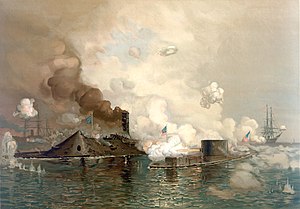CSS Virginia
[1] When the Confederate government took possession of the fully provisioned yard,[2] the base's new commander, Flag Officer French Forrest, contracted on May 18 to salvage the wreck of the frigate.
Stephen Mallory, Secretary of the Navy decided to convert Merrimack into an ironclad, since she was the only large ship with intact engines available in the Chesapeake Bay area.
[5] The hull's burned timbers were cut down past the vessel's original waterline, leaving just enough clearance to accommodate her large, twin-bladed screw propeller.
This forward and aft main deck and fantail were designed to stay submerged and were covered in 4-inch-thick (10 cm) iron plate, built up in two layers.
From reports in Northern newspapers, Virginia's designers were aware of the Union plans to build an ironclad and assumed their similar ordnance would be unable to do much serious damage to such a ship.
[6] Merrimack's steam engines, now part of Virginia, were in poor working order; they had been slated for replacement when the decision was made to abandon the Norfolk naval yard.
Despite an all-out effort to complete her, the new ironclad still had workmen on board when she sailed into Hampton Roads with her flotilla of five CSN support ships: Raleigh (serving as Virginia's tender) and Beaufort, Patrick Henry, Jamestown, and Teaser.
Congress, now set ablaze by the retaliatory shelling, burned for many hours into the night, a symbol of Confederate naval power and a costly wake-up call for the all-wood Union blockading squadron.
Her hanging port side anchor was lost after ramming Cumberland; the bow was leaking from the loss of the ram's port side half; shot from Cumberland, Congress, and the shore-based Union batteries had riddled her smokestack, reducing her boilers' draft and already slow speed; two of her broadside cannon (without shutters) were put out of commission by shell hits; a number of her armor plates had been loosened; both of Virginia's 22-foot (6.7 m) cutters had been shot away, as had both 12-pounder anti-boarding/anti-personnel howitzers, most of the deck stanchions, railings, and both flagstaffs.
She had been rushed to Hampton Roads, still not quite complete, all the way from the Brooklyn Navy Yard, in hopes of defending the force of wooden ships and preventing "the rebel monster" from further threatening the Union's blockading fleet and nearby cities, like Washington, D.C.
While under tow, she nearly foundered twice during heavy storms on her voyage south, arriving in Hampton Roads by the bright firelight from the still-burning triumph of Virginia's first day of handiwork.
The smaller, nimbler, and faster Monitor was able to outmaneuver the larger, slower Virginia, but neither ship proved able to do any severe damage to the other, despite numerous shell hits by both combatants, many fired at virtually point-blank range.
Monitor had a much lower freeboard and only its single, rotating, two-cannon gun turret and forward pilothouse sitting above her deck, and thus was much harder to hit with Virginia's heavy cannon.
The captain of the Monitor, Lieutenant John L. Worden, had taken a direct gunpowder explosion to his face and eyes, blinding him, while looking through the pilothouse's narrow, horizontal viewing slits.
Lieutenant Jones wanted to continue the fight, but the pilots emphasized that the Virginia had "nearly three miles to run to the bar" and that she could not remain and "take the ground on a falling tide."
On April 11, the Confederate Navy sent Lieutenant Joseph Nicholson Barney, in command of the paddle side-wheeler CSS Jamestown, along with Virginia and five other ships in full view of the Union squadron, enticing them to fight.
Since Virginia was now a steam-powered heavy battery and no longer an ocean-going cruiser, her pilots judged her not seaworthy enough to enter the Atlantic, even if she were able to pass the Union blockade.
[18] Numerous souvenirs, ostensibly made from salvaged iron and wood raised from Virginia's sunken hulk, have found a ready and willing market among Civil War enthusiasts and eastern seaboard residents.
However, the provenance of many of these artifacts is impossible to prove, which has given rise to the humorous adage that "if you took all the iron and all the wood supposedly collected from the [wreck of the CSS Virginia], you'd have enough to outfit a fleet of ironclads.





